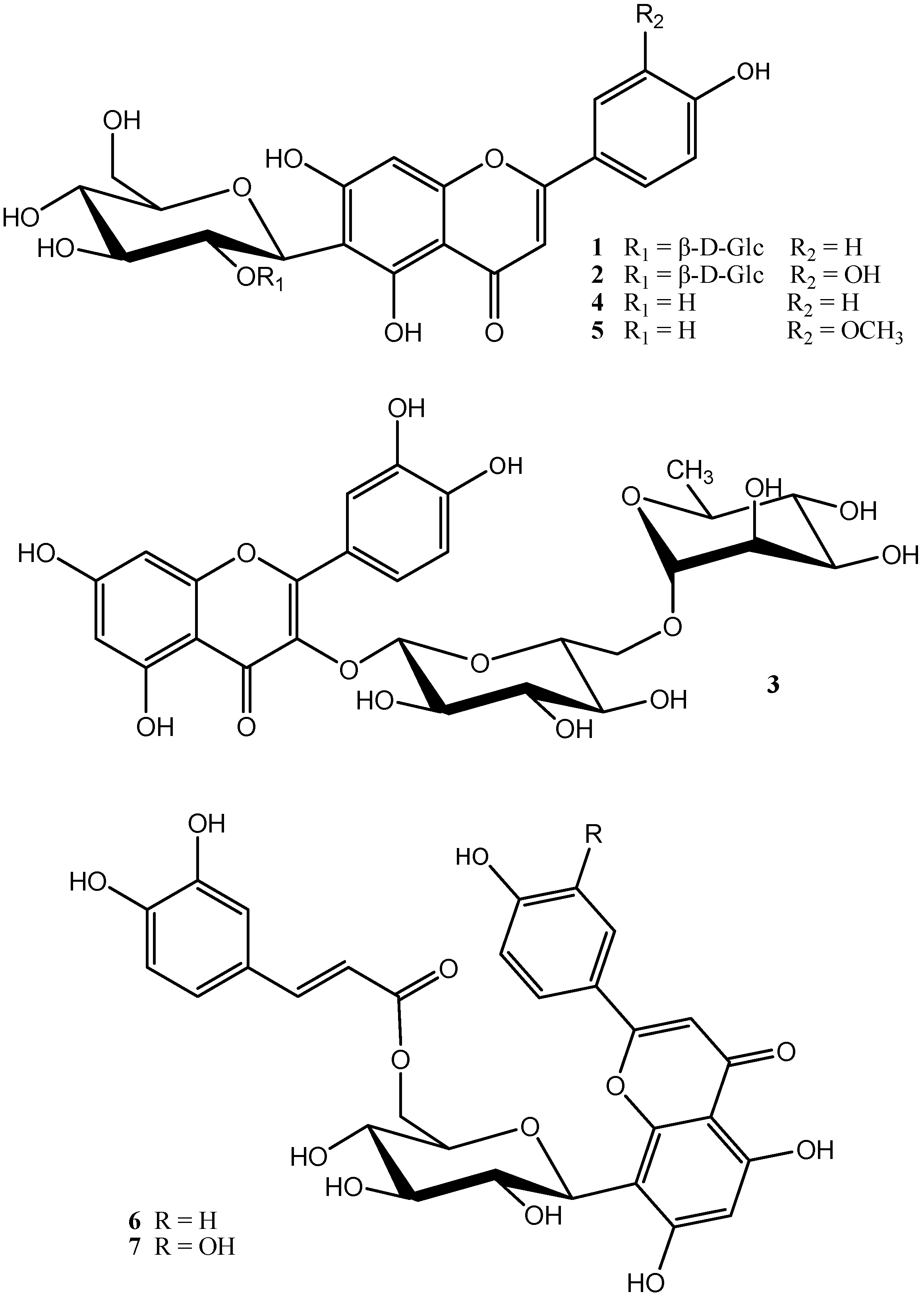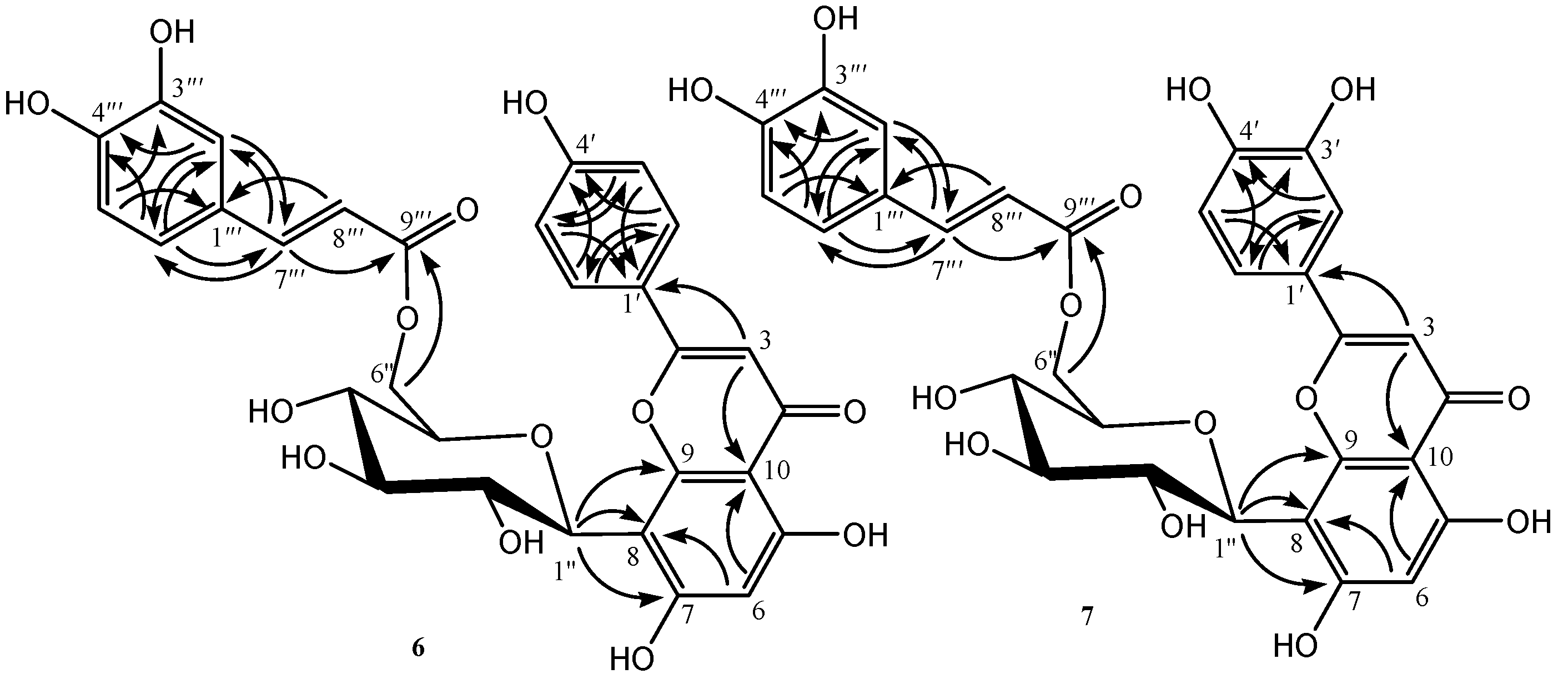Flavonoid Glycosides and Their Derivatives from the Herbs of Scorzonera austriaca Wild
Abstract
:1. Introduction
2. Results and Discussion
3. Experimental Section
3.1. General Information
3.2. Extraction and Isolation
3.3. In Vitro Hepatoprotective Activity
4. Conclusions
Acknowledgments
Author Contributions
Conflicts of Interest
References
- The Editorial Board of Zhong Hua Ben Cao of State Administration of Traditional Chinese Medicine of the People’s Republic of China. Zhong Hua Ben Cao, 1st ed.; Scientific and Technical Publishers: Shanghai, China, 1999; Volume 7, pp. 939–941. [Google Scholar]
- Wang, G.S.; Yang, X.H.; Zhou, X.P. Aplication of the extract of Scorzonera austriaca in Preparing Medicine to Treat Hepatitis. China Patent 2011102552351, 24 July 2013. [Google Scholar]
- Xie, Y.; Wang, J.; Geng, Y.M.; Qu, Y.F.; Zhang, Z.; Wang, G.S. Experimental studies on inhibitory effects of total flavonoids in Scorzonera austriaca Wild on hepatitis B virus in vitro. Chin. J. Biochem. Pharm. 2015, 35, 41–44. [Google Scholar]
- Zhang, T.W.; Xie, Y.; Zhang, Z.; Wang, G.S. Study on hepatoprotective effects of total flavonoids in Scorzonera austriaca Wild in vivo and in vitro. Chin. J. Biochem. Pharm. 2015, 35, 6–9. [Google Scholar]
- Ahmed, M.; Wang, F.; Levin, A.; Le, C.; Eltayebi, Y.; Houghton, M.; Tyrrell, L.; Barakat, K. Targeting the Achilles heel of the hepatitis B virus: A review of current treatments against covalently closed circular DNA. Drug Discov. Today 2015, 20, 548–556. [Google Scholar] [CrossRef] [PubMed]
- World Health Organization. Hepatitis B. Fact sheet no. 204. Updated 2015. Available online: http://www.who.int/mediacentre/factsheets/fs204/en/ (accessed on 18 September 2015).
- Lozano, R.; Naghavi, M.; Foreman, K. Global and regional mortality from 235 causes of death for 20 age groups in 1990 and 2010: A systematic analysis for the Global Burden of Disease Study 2010. Lancet 2012, 380, 2095–2128. [Google Scholar] [CrossRef]
- Zhang, F.; Wang, G. A review of non-nucleoside anti-hepatitis B virus agents. Eur. J. Med. Chem. 2014, 75, 267–281. [Google Scholar] [CrossRef] [PubMed]
- Perrillo, R.P. Overview of treatment of hepatitis B: Key approaches and clinical challenges. Semin. Liver Dis. 2004, 24 (Suppl. 1), 23–29. [Google Scholar] [CrossRef] [PubMed]
- Grimm, D.; Thimme, R.; Blum, H.E. HBV life cycle and novel drug targets. Hepatol Int. 2011, 5, 644–653. [Google Scholar] [CrossRef] [PubMed]
- Liaw, Y.F. HBeAg seroconversion as an important end point in the treatment of chronic hepatitis B. Hepatol. Int. 2009, 3, 425–433. [Google Scholar] [CrossRef] [PubMed]
- Kang, L; Pan, J.Q.; Wu, J.F.; Hu, J.L.; Sun, Q.; Tang, J. Anti-HBV Drugs: Progress, Unmet Needs, and New Hope. Viruses 2015, 7, 4960–4977. [Google Scholar] [CrossRef] [PubMed]
- Xu, F.F.; Fan, C.L.; Wang, L.; Wang, G.C.; Zhang, X.Q.; Ye, W.C. Chemical constituents from the seeds of Hovenia acerba. J. Jinan Univ. (Nat Sci. Med. Edit.) 2011, 32, 304–306. [Google Scholar]
- Besson, E.; Dellamonica, G.; Chopin, J.; Markham, K.R.; Kim, M.; Koh, H.S.; Fukami, H. C-glycosylflavones from Oryza sativa. Phytochemistry 1985, 24, 1061–1064. [Google Scholar] [CrossRef]
- Xie, Y.; Wang, J.; Geng, Y.M.; Zhang, Z.; Qu, Y.F.; Wang, G.S. Pheonolic compounds from the fruits of Viburnum sargentii Koehne. Molecules 2015, 20, 14377–14385. [Google Scholar] [CrossRef] [PubMed]
- Li, Y.W.; Li, R.J.; Yuan, L.Y.; Chang, Y.; Wang, X.L.; Chen, L.H. Chemical constituents from flower of Gentiana tibetica. Chin. Tradit. Herb. Drugs 2015, 46, 2052–2056. [Google Scholar]
- Liang, J.; Li, S.H.; Chen, C.Q. Chemical constituents in Swertia davidi. Chin. Tradit. Herb. Drugs 2014, 45, 919–923. [Google Scholar]
- Wang, J.; Wang, N.L.; Yao, X.S.; Kitangaka, S. Caffeoyl quinic acid derivatives from Bidens parviflora and their antihistamine release activities. Chin. Tradit. Herb. Drugs 2006, 37, 966–970. [Google Scholar]
- Liu, X.; Zhang, Z.L.; Wang, Z.; He, L.; Peng, C.; Wang, G.S. Isolation and structure identification of flavonoid glycosides from Scorzonera austriaca Wild. J. Jilin Univ. (Med. Edit.) 2012, 38, 595–597. [Google Scholar]
- Leitao, S.G.; Kaplan, M.A.C.; Delle Monache, F. Phenylpropanoid glucosides from Aegiphila obducta. J. Nat. Prod. 1994, 57, 1703–1707. [Google Scholar] [CrossRef] [PubMed]
- Li, Q.M.; Wang, G.S. Isolation and structure identification of flavonoid glycosides from Scorzonera ruprechtiana Lipsch et Krasch. J. Jilin Univ. (Med. Edit.) 2010, 36, 10–13. [Google Scholar]
- Wu, Y.H.; Yang, L.X.; Wang, F.; Wu, X.M.; Zhou, C.X.; Shi, S.Y.; Mo, J.X.; Zhao, Y. Hepatoprotective and antioxidative effects of total phenolics from Laggera pterodonta on chemical-induced injury in primary cultured neonatal rat hepatocytes. Food. Chem. Toxicol. 2007, 45, 1349–1355. [Google Scholar] [CrossRef] [PubMed]
- Seglen, P.O. Preparation of rat liver cells: III. Enzymatic requirements for tissue dispersion. Exp. Cell Res. 1973, 82, 391–398. [Google Scholar] [CrossRef]
- Sample Availability: Samples of the compounds 1–7 are available from the authors.


| No. | 6 | 6′ | 7 | 7′ | ||||||
|---|---|---|---|---|---|---|---|---|---|---|
| δC | δH J (Hz) | HMBC (H→C) | δC | δH J (Hz) | δC | δH J (Hz) | HMBC (H→C) | δC | δH J (Hz) | |
| Aglycone moiety | ||||||||||
| 2 | 163.6 | 163.9 | 163.9 | 164.2 | ||||||
| 3 | 102.3 | 6.80 (1H, s) | 103.9, 121.2 | 102.4 | 6.77 (1H, s) | 102.4 | 6.68 (1H, s) | 104.1, 121.8 | 102.5 | 6.64 (1H, s) |
| 4 | 182.0 | 182.0 | 182.0 | 182.1 | ||||||
| 5 | 161.7 | 161.1 | 160.6 | 160.5 | ||||||
| 6 | 98.2 | 6.28 (1H, s) | 103.9, 104.2 | 98.1 | 6.27 (1H, s) | 98.1 | 6.29 (1H, s) | 104.1 | 98.2 | 6.27 (1H, s) |
| 7 | 163.0 | 162.7 | 162.6 | 162.6 | ||||||
| 8 | 104.2 | 104.6 | 104.1 | 104.6 | ||||||
| 9 | 160.5 | 160.4 | 156.0 | 156.1 | ||||||
| 10 | 103.9 | 103.9 | 104.1 | 104.1 | ||||||
| 1′ | 121.2 | 121.6 | 121.8 | 122.1 | ||||||
| 2′ | 128.6 | 8.01 (1H, d, J = 7.2 Hz) | 128.6, 156.0, 163.6 | 128.9 | 8.02 (1H, d, J = 7.9 Hz) | 113.9 | 7.48 (1H, s) | 119.0, 150.0, 163.9 | 114.2 | 7.48 (1H, s) |
| 3′ | 116.0 | 6.95 (1H, d, J = 7.2 Hz) | 121.2, 116.0 | 115.8 | 6.89 (1H, d, J = 7.9 Hz) | 146.0 | 145.9 | |||
| 4′ | 156.0 | 156.0 | 150.0 | 149.7 | ||||||
| 5′ | 116.0 | 6.95 (1H, d, J = 7.2 Hz) | 121.2, 116.0 | 115.8 | 6.89 (1H, d, J = 7.9 Hz) | 115.6 | 6.94 (1H, d, J = 8.1 Hz) | 121.8, 146.0 | 115.8 | 6.86 (1H, d, J = 8.3 Hz) |
| 6′ | 128.6 | 8.01 (1H, d, J = 7.2 Hz) | 128.6, 156.0, 163.6 | 128.9 | 8.02 (1H, d, J = 7.9 Hz) | 119.0 | 7.53 (1H, d, J = 8.1 Hz) | 113.9, 150.0, 163.9 | 119.5 | 7.53 (1H, d, J = 8.3 Hz) |
| Sugar moiety | ||||||||||
| 1″ | 73.6 | 4.77 (1H, d, J = 9.9 Hz) | 70.7, 78.4, 104.2, 160.5, 163.0 | 73.4 | 4.79 (1H, d, J = 9.6 Hz) | 73.6 | 4.75 (1H, d, J = 9.9 Hz) | 70.6, 78.5, 104.1, 156.0, 162.6 | 73.5 | 4.68 (1H, d, J = 9.4 Hz) |
| 2″ | 70.7 | 3.95 (1H, m) | 70.8 | 3.84 (1H, m) | 70.6 | 3.93 (1H, m) | 70.9 | 3.84 (1H, m) | ||
| 3″ | 78.4 | 3.32 (1H, m) | 78.6 | 3.26 (1H, m) | 78.5 | 3.31 (1H, m) | 78.8 | 3.31 (1H, m) | ||
| 4″ | 70.5 | 3.51 (1H, m) | 70.5 | 3.36 (1H, m) | 70.5 | 3.53 (1H, m) | 70.8 | 3.53 (1H, m) | ||
| 5″ | 78.3 | 3.51 (1H, m) | 81.8 | 3.36 (1H, m) | 78.5 | 3.54 (1H, m) | 82.0 | 3.54 (1H, m) | ||
| 6″ | 64.0 | 4.17 (1H, m), 4.48 (1H, m) | 166.7 | 61.3 | 3.51 (1H, m), 3.75 (1H, m) | 64.3 | 4.15 (1H, m), 4.54 (1H, m) | 166.8 | 61.7 | 3.56 (1H, m), 3.79 (1H, m) |
| Caffeoyl moiety | ||||||||||
| 1″′ | 125.3 | 125.4 | ||||||||
| 2″′ | 115.5 | 6.80 (1H, s) | 145.4, 148.4, 120.5 | 115.6 | 6.94 (1H, s) | 145.3, 148.3, 120.6 | ||||
| 3″′ | 145.5 | 145.3 | ||||||||
| 4″′ | 148.4 | 148.3 | ||||||||
| 5″′ | 115.7 | 6.70 (1H, d, J = 7.0 Hz) | 125.3, 145.5 | 115.8 | 6.73 (1H, d, J = 8.0 Hz) | 125.4, 145.3 | ||||
| 6″′ | 120.5 | 6.91 (1H, d, J = 7.0 Hz) | 115.5, 148.4, 145.4 | 120.6 | 6.85 (1H, d, J = 8.0 Hz) | 115.6, 148.3, 145.3 | ||||
| 7″′ | 145.4 | 7.40 (1H, d, J = 15.7 Hz) | 115.5, 120.5, 166.7 | 145.3 | 7.40 (1H, d, J = 15.8 Hz) | 115.6, 120.6, 166.8 | ||||
| 8″′ | 113.6 | 6.15 (1H, d, J = 15.7 Hz) | 125.3 | 113.7 | 6.23 (1H, d, J = 15.8 Hz) | 125.4 | ||||
| 9″′ | 166.7 | 166.8 | ||||||||
| Group | Dose | ALT (IU/L) | Relative Protection(%) |
|---|---|---|---|
| Control | 12.6 ± 2.4 | 100 | |
| CCl4-treated | 101.5 ± 4.5 * | 0 | |
| Silibinin | 50 μM | 40.8 ± 2.9 ## | 68.3 |
| 6 | 25 μM | 86.7 ± 3.6 # | 16.5 |
| 50 μM | 54.5 ± 3.7 ## | 52.9 | |
| 100 μM | 38.2 ± 3.8 ## | 71.2 | |
| 7 | 25 μM | 76.6 ± 3.5 ## | 28.1 |
| 50 μM | 42.5 ± 2.4 ## | 66.4 | |
| 100 μM | 28.8 ± 3.5 ## | 81.2 |
© 2016 by the authors. Licensee MDPI, Basel, Switzerland. This article is an open access article distributed under the terms and conditions of the Creative Commons Attribution (CC-BY) license ( http://creativecommons.org/licenses/by/4.0/).
Share and Cite
Xie, Y.; Guo, Q.-S.; Wang, G.-S. Flavonoid Glycosides and Their Derivatives from the Herbs of Scorzonera austriaca Wild. Molecules 2016, 21, 803. https://doi.org/10.3390/molecules21060803
Xie Y, Guo Q-S, Wang G-S. Flavonoid Glycosides and Their Derivatives from the Herbs of Scorzonera austriaca Wild. Molecules. 2016; 21(6):803. https://doi.org/10.3390/molecules21060803
Chicago/Turabian StyleXie, Yang, Qiu-Shi Guo, and Guang-Shu Wang. 2016. "Flavonoid Glycosides and Their Derivatives from the Herbs of Scorzonera austriaca Wild" Molecules 21, no. 6: 803. https://doi.org/10.3390/molecules21060803
APA StyleXie, Y., Guo, Q.-S., & Wang, G.-S. (2016). Flavonoid Glycosides and Their Derivatives from the Herbs of Scorzonera austriaca Wild. Molecules, 21(6), 803. https://doi.org/10.3390/molecules21060803






